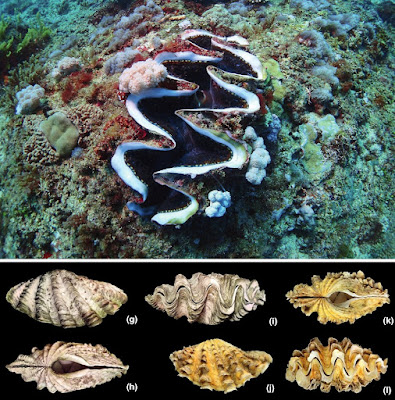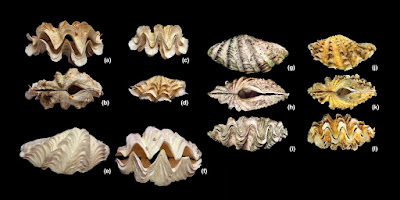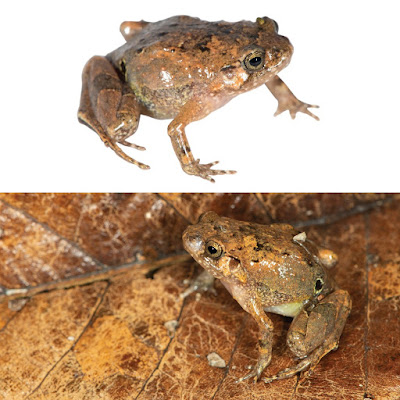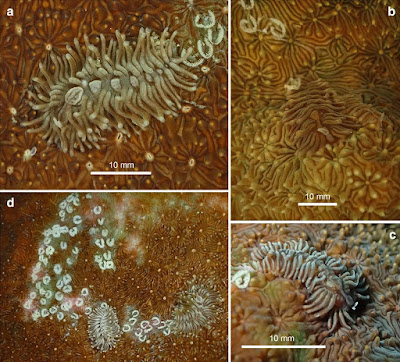[Most Recent Entries] [Calendar View]
Tuesday, June 16th, 2020
| Time | Event | ||||||
| 6:04a | [Mollusca • 2020] Phylogeographical Patterns and A Cryptic Species provide New Insights Into Western Indian Ocean Giant Clams (Genus Tridacna) Phylogenetic Relationships and Colonization History
Abstract Aim: The unique biodiversity in the Red Sea is the result of complex ecological and evolutionary processes driven by Pleistocene climatic change. Here we investigate the species diversity, phylogenetic relationships and phylogeographical patterns of giant clams in the Western Indian Ocean (WIO) and the Red Sea to explore scenarios of marine speciation in this under‐studied region. Location: Mozambique Channel, Madagascar, and the Mascarene Islands (WIO); the Farasan Islands (Red Sea). Taxon: Giant clams of the genus Tridacna (Cardiidae: Tridacninae). Methods: Giant clams were sampled as complete organisms or through underwater biopsies. Nuclear (28S ) and mitochondrial (16S and COI ) DNA sequences were subjected to Bayesian and maximum likelihood analyses to generate a phylogenetic hypothesis for all known species within the genus Tridacna . Bayesian inference with molecular and fossil calibration was used to infer their colonization history. Results: From the 10 genetically distinct clades recovered from the analyses of 253 sequenced specimens, five distinct Tridacna lineages were sampled, three of which were endemics of the WIO and the Red Sea. Each lineage corresponded to a distinct species, except one grouping the two formerly known WIO endemics, T. lorenzi and T. rosewateri. This lineage clustered with two other well‐supported lineages: the Red Sea endemic T. squamosina, and a previously unrecognized lineage, restricted to the WIO, for which we resurrect the long‐forgotten name T. elongatissima Bianconi, 1856. For the two other species sampled (T. maxima and T. squamosa), contrasting phylogeographical patterns were observed. Main conclusions: Our data confirm the validity of the species T. rosewateri, a WIO endemic genetically indistinguishable from T. lorenzi, which should be considered a junior synonym. The phylogenetic placement of the newly resurrected T. elongatissima provides insights into the probable origin of T. squamosina, which split from its sister species no later than 2 Ma, likely during Middle Pleistocene glacial periods. Two scenarios are discussed. Our results also suggest that T. maxima invaded the Red Sea more recently and that contemporary gene flow between Red Sea and WIO T. maxima is highly restricted. The deep Red Sea partition observed in T. squamosa suggests a much older divergence and raises the question of a possible cryptic lineage. Keywords: biodiversity, biogeographical barriers, cardiidae, population genetics, Red Sea, species distribution, systematics
Cécile Fauvelot, Dario Zuccon, Philippe Borsa, Daphné Grulois, Hélène Magalon, Florentine Riquet, Serge Andréfouët, Michael L. Berumen, Tane H. Sinclair‐Taylor, Pauline Gélin, Faustinato Behivoke, Jan Johan ter Poorten, Ellen E. Strong and Philippe Bouchet. 2020. Phylogeographical Patterns and A Cryptic Species provide New Insights Into Western Indian Ocean Giant Clams Phylogenetic Relationships and Colonization History. Journal of Biogeography. DOI: 10.1111/jbi.13797 The forgotten giants of the Western Indian Ocean reefs | ||||||
| 7:50a | [Herpetology • 2020] Rhombophryne ellae • Diamond Frogs Forever: A New Species of Rhombophryne Boettger, 1880 (Microhylidae, Cophylinae) from Montagne d’Ambre National Park, northern Madagascar
Abstract Although taxonomic progress on the frogs of Madagascar is currently proceeding at an unprecedented pace, the goal of completing the amphibian inventory of this hyper-diverse island is still far off. In part this is because more new species continue to be discovered at a high rate, in some cases within well-studied areas. Here, I describe Rhombophryne ellae sp. nov., a new species of diamond frog discovered in Montagne d’Ambre National Park in northern Madagascar in 2017. This new species is highly distinctive in having orange flash-markings on its hindlimbs (not known from any described species of Rhombophryne), and large, black inguinal spots (larger than in all other described Rhombophryne species). It is separated from all named species of Rhombophryne by a substantial uncorrected pairwise distance in the 16S rRNA mitochondrial barcode marker (> 7%) and is most closely related to an undescribed candidate species from Tsaratanana in northern Madagascar. Rhombophryne ellae sp. nov. adds another taxon to the growing list of cophyline microhylids that have red to orange flash-markings, the function of which remains unknown and which has clearly evolved repeatedly in this radiation. The discovery of such a distinctive species within a comparatively well-studied park points toward the low detectability of semi-fossorial frogs and the role of inclement weather in increasing that detectability. Key Words: Amphibia, Anura, micro-CT, molecular genetics, osteology Rhombophryne ellae sp. nov., systematics, taxonomy Rhombophryne ellae sp. nov. Diagnosis: Rhombophryne ellae sp. nov. is assigned to the genus Rhombophryne based on its plump body shape, presence of vomerine and maxillary teeth, curved clavicle, knob-shaped terminal phalanges, and phylogenetic relationships. It is distinguished by the following unique combination of characters: (1) adult or subadult female SVL 24.9 mm, (2) distinctly enlarged inner metatarsal tubercle, (3) absence of superciliary spines, (4) orange flash-markings on its posterior thighs in life, and (5) presence of large and distinct black inguinal spots. .... Natural history, distribution, and conservation status: The holotype was collected at 892 m a.s.l. in rainforest on Montagne d’Ambre during the day actively jumping away from trampling feet during moderate to heavy rain brought about by Cyclone Ava. Its gut contents included three whole ants and one ant head, seemingly belonging to two different species (one of the whole ants is diminutive), the head of a jumping spider (Salticidae), and the elytra and other body parts of a beetle. Nothing more is known of the ecology of this species, though it is probable that its reproductive mode and ecology is similar to other litter-dwelling Rhombophryne species (Scherz et al. 2016a). As the species is known from a single individual, its Red List status cannot be confidently estimated. However, the syntopically occurring Stumpffia species have been suggested to be Near Threatened due to their small range and presumed micro-endemicity within a well-protected forest, and this likely applies to R. ellae sp. nov. as well. Etymology: It is with great pleasure that I dedicate this charming little frog to my partner, Dr Ella Z. Lattenkamp, in appreciation of her love, support, and infinite patience, and in celebration of the completion of her PhD. Mark D. Scherz. 2020. Diamond Frogs Forever: A New Species of Rhombophryne Boettger, 1880 (Microhylidae, Cophylinae) from Montagne d’Ambre National Park, northern Madagascar. Zoosystematics and Evolution. 96(2): 313-323. DOI: 10.3897/zse.96.51372 Shining like a diamond: A new species of diamond frog from northern Madagascar | ||||||
| 9:27a | [Mollusca • 2020] Phestilla viei • A New Species of Coral-feeding Nudibranch (Gastropoda) from the Gulf of Thailand
Abstract The validity and position of the Indo Pacific genus Phestilla Bergh, 1874 (Fionoidea: Trinchesiidae) have been subject of some controversy as a result of several recent studies, which have sequentially synonymized or re-established it. At present, the genus includes eight valid species, the most of them described in the nineteenth and twentieth centuries, and all but one feeding on scleractinian corals of four genera: Porites Link, 1807 (Poritidae), Tubastraea Lesson, 1830, Dendrophyllia Blainville, 1830 (Dendrophylliidae) and Montipora Blainville, 1830 (Acroporidae). The discovery of an unknown Phestilla species feeding on Pavona explanulata (Lamarck, 1816) (Agariciidae) in Koh Tao, Thailand, motivates this work, in which this new species is described providing morphoanatomical and molecular characters. In addition, its systematic position and ecological significance as coral parasite are discussed. Keywords: Fionoidea, Trinchesiidae, Ecto-parasite, Phestilla Bergh, 1874, Pavona explanulata (Lamarck, 1816), Camouflage Systematics Order Nudibranchia Cuvier, 1814 (in Blainville 1814). Superfamily Fionoidea Gray, 1857. Family Trinchesiidae Nordsieck, 1972. Genus Phestilla Bergh, 1874. Phestilla viei Mehrotra, Caballer & Chavanich sp. nov. Phestilla sp.: Fritts-Penniman 2016: 116, Fig. 3.1 E. Phestilla sp. 2: Gosliner et al. 2008: 372; Gosliner et al. 2015: 357. Tenellia sp. 83: Gosliner et al. 2018: 300. ?Tenellia D4: Fritts-Penniman et al. 2020: Fig. 1G. Derivatio nominis: Phestilla viei Mehrotra, Caballer & Chavanich sp. nov. is named in honor of Mr. Vie Panyarachun for his years of facilitating citizen science and contributions in curating records of sea slug diversity in Thai waters, and his continued efforts as a marine naturalist. Rahul Mehrotra, Spencer Arnold, Adam Wang, Suchana Chavanich, Bert W. Hoeksema and& Manuel Caballer. 2020. A New Species of Coral-feeding Nudibranch (Mollusca: Gastropoda) from the Gulf of Thailand. Marine Biodiversity. 50: 36. DOI: 10.1007/s12526-020-01050-2 A New Species of Coral-Eating Nudibranch |
| << Previous Day |
2020/06/16 [Calendar] |
Next Day >> |





















